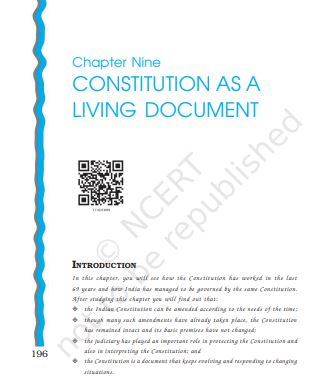‘NCERT Solutions for Class 11 Political Science Chapter 9 Constitution As A Living Document‘ PDF Quick download link is given at the bottom of this article. You can see the PDF demo, size of the PDF, page numbers, and direct download Free PDF of ‘Ncert Class 11 Political Science Chapter 9 Exercise Solution’ using the download button.
Constitution As A Living Document NCERT Textbook With Solutions Book PDF Free Download

Chapter 9: Constitution As A Living Document
It is not uncommon for nations to rewrite their constitutions in response to changed circumstances or change of ideas within the society or even due to political upheavals.
The Soviet Union had four constitutions in its life of 74 years (1918, 1924, 1936 and 1977). In 1991, the rule of the Communist Party of the Soviet Union came to an end, and soon the Soviet
federation disintegrated.
After this political upheaval, the newly formed Russian Federation adopted a new constitution in
1993. But look at India. The Constitution of India was adopted on 26 November 1949.
Its implementation formally started from 26 January 1950. More than 69 years after that, the same constitution continues to function as the framework within which the government of our
country operates.
Is it that our Constitution is so good that it needs no change? Was it that our Constitution makers were so farsighted and wise that they had foreseen all the changes that would take place in the
future?
In some sense both the answers are correct. It is true that we have inherited a very robust Constitution.
The basic framework of the Constitution is very much suited to our country. It is also true that the Constitution makers were very farsighted and provided for many solutions for future situations.
But no constitution can provide for all eventualities. No document can be such that it needs no change.
Then how does the same Constitution continue to serve the country? One of the answers to such questions is that our Constitution accepts the necessity of modifications according to changing needs of the society.
Secondly, in the actual working of the Constitution, there has been enough flexibility in interpretations.
Both political practice and judicial rulings have shown maturity and flexibility in implementing the Constitution. These factors have made our Constitution a living document rather than a closed and static rulebook.
In any society, those responsible for drafting the constitution at a particular time would face one common challenge: the provisions of the constitution would naturally reflect efforts to tackle the problems that the society is facing at the time of making of the constitution.
At the same time, the constitution must be a document that provides the framework of the government for the future as well.
Therefore, the constitution has to be able to respond to the challenges that may arise in the future. In this sense, the constitution will always have something that is contemporary and something that has a more durable importance.
At the same time, a constitution is not a frozen and unalterable document. It is a document made by human beings and may need revisions, changes and reexamination.
It is true that the constitution reflects the dreams and aspirations of the concerned society. It must also be kept in mind that the constitution is a framework for the democratic governance of the society. In this sense, it is an instrument that societies create for themselves
| Author | NCERT |
| Language | English |
| No. of Pages | 24 |
| PDF Size | 2.1 MB |
| Category | Political Science |
| Source/Credits | ncert.nic.in |
NCERT Solutions Class 11 Political Science Chapter 9 Constitution As A Living Document
Question 1.
Choose the correct statement from the following.
A constitution needs to be amended from time to time because,
1. Circumstances change and require suitable changes in the constitution.
2. A document written at one point of time becomes outdated after some time.
3. Every generation should have a constitution of its own liking.
4. It must reflect the philosophy of the existing government.
Answer:
Because circumstances change and require suitable changes in the constitution.
Question 2.
Write True / False against the following statements.
(a) The President cannot send back an amendment bill for reconsideration of the Parliament.
(b) Elected representatives alone have the power to amend the Constitution.
(c) The Judiciary cannot initiate the process of constitutional amendment but can effectively change the Constitution by interpreting it differently.
(d) The Parliament can amend any section of the Constitution.
Answer:
(a) True
(b) True
(c) True
(d) False
Question 3.
Which of the following are involved in the amendment of the Indian Constitution? In what way are they involved?
(a) Voters
(b) President of India
(c) State Legislatures
(d) Parliament
(e) Governors
(f) Judiciary
Answer:
(a) Voters are not involved in the amendment of the constitution.
(b) President of India is involved in the amendment of constitution. An amendment bill after ratification by two houses of parliament goes to the president for his approval, he has no power to send this amendment bill back for reconsideration.
(c) State Legislatures are involved for some articles of constitution related to distribution of powers between the centre and states and articles related to representation, is necessary to be consulted with states. In some of the amendments, half of the states have to ratify the particular amendment bill.
(d) Parliament involves in the amendment because some bills/article are amended by simple majority. Some by special majority in both the houses of parliament separately and later, these are ratified by at least half of the states also.
(e) Governors have no role in the amendment of constitution of India except those articles only which are ratified by half of the states. Because, governor also signs on the bills passed by state legislatures.
(f) Judiciary involves to specify the basic structure or to take care that in any case, constitution’s basic structure should not be changed, only amendments are required.
NCERT Class 11 Political Science Textbook Chapter 9 With Answer PDF Free Download
